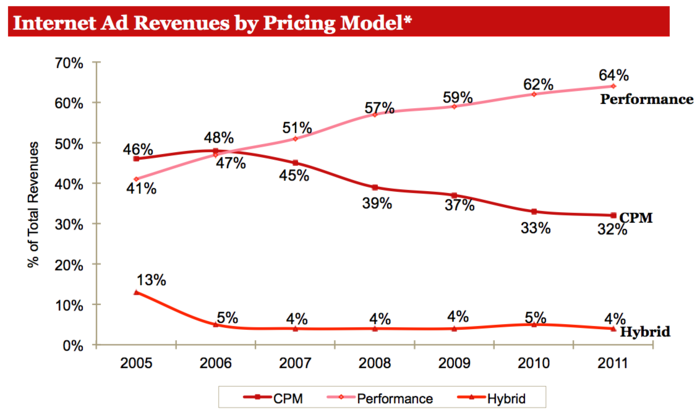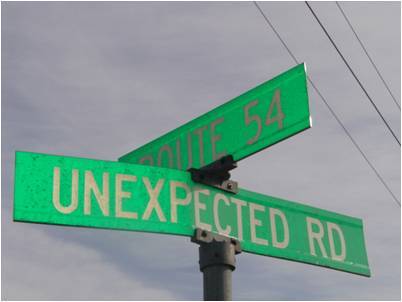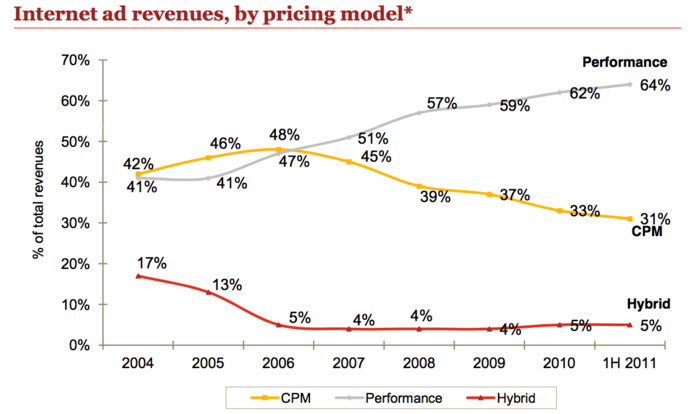Redefining Premium Content Towards CPM Zero
- Edit
- Delete
- Tags
- Autopost
Say Goodbye to Hollywood
When Ari Emanuel, co-CEO of talent agency William Morris Endeavor said that Northern California is just pipes and needs Premium Content it’s clear that he just doesn’t get it. There is no such thing as premium content. There are only two things premium on a mass scale anymore - distribution and devices.
Massive media fragmentation fueled by the Internet has forever redefined what is ‘premium’ content. The democratization of media – the ability for a critical mass of people (now virtually the entire world) to create, distribute and find content killed the old model of premium. Modern Family is a good TV show but when I can more easily stream a concert like this through my HDTV at any moment I want I’m pretty sure “premium content” has been redefined.
Since the web is the root cause of death for premium content it makes sense that the effect is no better exemplified than in web publishing. Since the advent display advertising publishers have sought to categorize and valuate their content in ways that were familiar to traditional media buyers. No media channel has promoted the idea of or value for premium content more than digital. Thus, print media’s inside front and back covers became the homepages and category pages on portals. Like print, these were areas where the most eyeballs could be reached.
But a funny thing happened in digital behavior. People skipped over the front inside cover and went right to content that was relevant to them. Search’s ability to fracture content hierarchies and deliver relevance not only became the most loved and valuable application of the web, it destroyed the idea of premium content all together. In reality, premium never really existed in a user-controlled medium because it was never based on anything that had to do with what the user wanted. It was based on the traditional ad metric of “reach” when in this medium, decisions about what is premium are determined by on-demand ability and relevance.
Sinking of the Britannica
The beauty of this medium is in the measurement of it. Validation for the drowning of premium beyond the fact that Wikipedia destroyed Encyclopedia Britannica rests in the performance of digital media. A funny thing happened as advertising performance became more measured. Advertisers discovered premium didn’t nearly matter as much as they thought. There were better ways to drive performance that yielded better and more measureable results. The ability to match messaging to people on-request and in a relevant way was more valuable in this medium than some content provider idea of what was “premium.” In this medium the public not the publisher determines what is premium.
As realtime rules based matching technology continues to improve performance advertising and marketing itself continues to grow at the expense of premium advertising. Today, despite those trying to hold on to the past, premium is little more than an exercise in brand borrowing and little else. Despite the best efforts of the IAB to bring Brand advertising to Digital it has fallen as a percentage of ad spend for five straight years. In the world we live in today Mr. Emanuel’s $9 billion dollar upfront for network TV primetime advertising is $1.5 billion less in ad revenue than Google made last quarter.
What this all means for the future of digital media (and thus all media eventually) is that it’s headed to “CPM Zero.” Look around - all the digital advertising powers - Google, Facebook, Twitter, Amazon - are selling based one thing. Performance. They are not selling on the premium sales mechanism of CPM. When ‘CPM Zero’ happens, and it will, these forces pushing the digital ad industry forward win. They own the customer funnel and they will own the future of marketing and advertising. It begs one big question. Where does this leave content creators and publishers?
Don't Fear the Reaper
Publishers will never be able to put the CPM sales genie back in the bottle. CMOs and advertisers are already finding out that they are paying too much for premium. Go ask GM what they think. What publishers are finding out is that they are no longer selling their media; it’s being bought. Purchased from a marketplace with infinite inventory in a wild west of data. Therein lies the publisher’s ace in the hole and the strategies and tactics digital publishers (and eventually broadcasters) can use to combat the death of premium.
Like Search, Publishers need to have two crucial components to their marketplaces. They need the tension of scarcity in the marketplace. That will drive up demand and force advertisers to spend the time working on improving their performance. This was the cherry on the sundae for Google as a $1billion industry - Conversion Testing and Content Targeting grew out of nowhere to support spends in Search. Most every dollar saved with optimization went to drive more volume – or back to Google. They need a unique currency for the marketplace. Keywords were a completely new way to buy media. Nothing has ever worked better. Facebook is selling Actions with OpenGraph. Ultimately advertisers are buying customers not keywords or actions but there is a unique window of opportunity for publishers at this moment in time to create something new and uniquely people, not page focused.
The tactics used to fuel these strategies all rely on one natural resource - data. Publishers have diamonds and gold in beneath the surface of their properties. Mining these data nuggets and using them to improve the performance of their media is the sole hope publishers have competing in the world of “CPM Zero.” Only publishers can uniquely wrap their data with their media and drive performance in a manner unique to the marketplace. That’s what Google does. That’s what Facebook does. That’s what Twitter does. The scarcity mentioned above is created because the realtime understanding of site visitor interest and intent is only derived using first party data as rules and integration with the publisher ad server for delivery. So pubs are really left with one choice – take control of their data and use it for their benefit creating an understanding of WHY people are buying their media and how it performs. Or let Google, Facebook, third-party et al come in and grab their data and know nothing about why it’s being bought and how much it’s being sold.
The ability to match messaging to people on-request and in a relevant way is within the publisher’s domain. It is the most premium form of advertising currency ever created and will deliver an order of magnitude more value. It will fuel the 20% YoY growth of digital advertising and marketing for the next 15 years. Who captures the majority of that value, the advertiser or the publisher, is the only question remaining.




